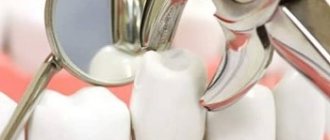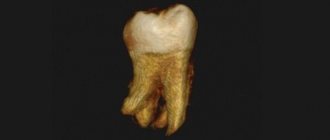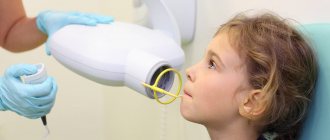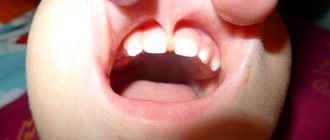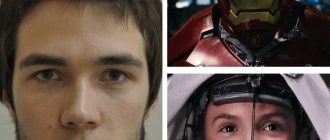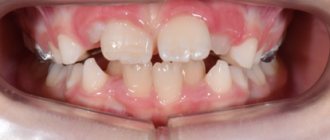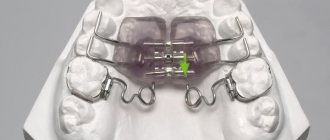The replacement of baby teeth with permanent ones is a natural physiological process that every child experiences. It usually begins in preschool age and proceeds without difficulty. But parents need to approach it responsibly, since any violations when changing teeth are fraught with unpleasant consequences. This may be the formation of a malocclusion, uneven teeth, or the occurrence of a diastema (interdental gap).
In this article we will consider the correct sequence of tooth replacement, possible violations, and situations when consultation with a pediatric dentist is necessary.
Why and when do baby teeth change?
As the child grows, the dentofacial apparatus also develops. At approximately 4–6 years of age, the preparatory stage begins, during which interdental spaces appear. This prepares the place for permanent teeth in the primary dentition.
The process of replacing baby teeth with permanent teeth is a slow process, taking approximately 6 or 7 years (until adolescence). Active growth of the roots of permanent teeth activates the process of bone resorption - this is the destruction (dissolution) of milk roots, which leads to loosening and tooth loss. Standard diagram of the sequence of changing baby teeth in a child.
- Central lower incisors (5–7 years). They fall out one by one with a short time interval.
- Lateral incisors (7–8 years).
- First molars on the upper jaw, second molars on the lower jaw (9–11 years)
- Cone-shaped teeth (canines) at the age of 9–12 years.
- Second molars on the upper jaw and first molars on the lower jaw (10–13 years)
Not everyone's third molars (wisdom teeth) erupt. This is considered the norm. Most often, the optimal age for them is considered to be from 17 to 25 years.
Reference!
The later the first teeth erupted in infancy, the later they will be replaced in preschool age.
By the age of 15–16, a teenager’s permanent bite should number 28 units.
How dangerous is it to x-ray a child?
When prescribing x-ray examinations for children, dentists adhere to established standards. For children with baby teeth, examination is carried out once every 2 years. More frequent use of x-rays for a child can only be due to a serious need. According to WHO, it is permissible to conduct up to 6 studies per year without harm to a small patient.
Since we use the most advanced digital X-ray machines, the radiation dose for 1 procedure will not exceed 0.01-0.02 mSv. The study will not harm even a very small patient!
What deviations from the norm may there be?
Each child develops individually. Sometimes the timing of the replacement of certain teeth may differ from the generally accepted norm. Minor deviations are allowed up to 12 months. But sometimes the change in the primary bite begins too early or, on the contrary, the temporary teeth do not want to fall out.
Causes:
- long-term breastfeeding;
- severe infectious diseases in infancy;
- pathologies of intrauterine development.
Reference!
Dentists believe that a safer deviation is a late change in the primary occlusion than vice versa.
Let us consider in detail the common violations and their causes.
Early tooth loss
We can talk about such a pathology if a child’s baby teeth begin to fall out before the age of 5. Possible reasons:
- advanced multiple caries;
- injury;
- gum disease;
- manual loosening of the tooth.
In all these cases, consultation with a pediatric dentist is required.
Important!
Parents should record the time of tooth loss. If after 4 months the permanent tooth does not begin to emerge, then the help of a doctor is required.
In case of early unnatural tooth loss, it is advisable to conduct an X-ray diagnosis. This will help to identify possible damage to the permanent root rudiment in time and begin treatment. Otherwise, the child will need prosthetics in the future.
Late change from primary to permanent occlusion
The deadline for starting the process of changing baby teeth is 8 years. But this is considered a late shift. The disorder may be caused by:
- heredity;
- metabolic disorders;
- infectious diseases suffered in early childhood;
- mental disorders.
If after 8 years a child has not lost a single baby tooth, this is a reason to consult a doctor.
Reasons for late eruption
Normally, after a baby tooth falls out, it takes 1-2 months for the permanent tooth to erupt. This is the longest period. In most cases, the rudiments of a permanent tooth can already be seen at the site of the lost tooth.
But, if a child’s toothless smile persists for 3 months or more, then this is a cause for concern for parents.
Let's consider why such dental pathology occurs:
- Retention
– a common condition that mainly affects the incisors and canines. They cannot erupt due to dense gums or because they rest against neighboring teeth. There are complete and partial retention. With the full form, a healthy root is visible in the picture, but it is completely under the gum. With partial retention, only part of the crown is visible. In this case, surgical assistance is required.
- Edentia
– a congenital pathology in which there is a lack of rudiments of permanent dental units. Can be complete or partial (sparse teeth). A rare disease. Orthopedic treatment is required as early as possible.
- Impact
– delayed eruption in this pathology is associated with a mechanical obstacle, that is, the child has a supernumerary of dental units. In this case, the permanent root simply does not have room to erupt. Impaction can only be detected using a panoramic x-ray of the jaw.
The sooner the child is examined by a doctor, the higher the chance of having an even and complete dentition.
Possible problems when changing baby teeth
Common dental pathologies when changing a primary dentition to a permanent one include:
- Shark teeth. A phenomenon in which baby and permanent teeth are located parallel to each other, in 2 rows. This arrangement can interfere with the normal development of the dental system. But in most cases, the temporary root becomes loose, and the “extra” tooth falls out on its own. If this does not happen, removal at the doctor's office is recommended.
- Increased pain. Sometimes a change in the milk bite is accompanied by increased body temperature, redness of the gums and severe pain. These symptoms usually accompany early or late change of teeth. Inflammatory diseases of the oral cavity may also be the cause.
- The appearance of a hematoma.
In rare cases, when molars erupt, a hematoma occurs on the gum in the form of a small bubble with an accumulation of blood. This occurs due to severe eruption, which leads to rupture of blood vessels. The gums may be pale in color. Pain and discomfort occurs. If suppuration occurs, medical attention is required.
If pathological phenomena do not go away for a long time, and the child is irritable and complains of pain, be sure to visit the dentist.
Possible problems
Permanent teeth have just appeared, but this does not mean that there will not immediately be any problems associated with them. Parents should be aware of possible dental problems:
- lack of molars;
- pain in the molar area;
- crooked position of molars;
- molars fall out;
- injuries.
For any of these problems, it is important to contact a specialist in time to receive qualified help.
What not to do when baby teeth fall out
Incorrect actions of children and parents can lead to the formation of malocclusion, increased pain, or the formation of crooked teeth. To avoid this, it is recommended to adhere to the following rules:
- Don't help baby teeth fall out if they are straight and not loose. Even if, according to the child’s age, it is high time for him to have a toothless smile.
- Don't loosen your teeth with your hands. And do not pull them at home, for example, with a thread.
- Baby teeth are quite fragile in preschool age. Therefore, your child should not indulge in solid foods. The crown may break, but the root will remain in the gum.
- If a tooth falls out, do not allow your child to touch the socket with his tongue or hands. Gentle rinsing with antiseptic solutions or herbal decoctions is recommended.
If you have a fever, cough or lethargy, do not rush to resort to antiviral drugs. Poor health can be a harbinger of the imminent change of baby teeth.
Tips for parents
During the period of teeth change, you should enrich your baby’s food with foods that are rich in calcium. To prevent inflammation in your mouth, make it a habit to rinse your mouth every time you eat or have a snack. As permanent teeth erupt, offer your baby soft or liquid foods. Avoid hot drinks.
If slight bleeding occurs when a baby tooth falls out, do not use alcohol tinctures. Apply a cotton ball to the wound and do not allow food for 2 hours. In order to promptly identify possible irregularities in the eruption of the permanent dentition, it is recommended to record the date of baby tooth loss.
Beautiful, straight and healthy teeth in adults are the result of proper care in childhood. Therefore, parents should teach their child proper oral hygiene from the first tooth.
Development of tactics for correcting a child’s bite
Since the child is at an age when baby teeth are actively falling out and permanent teeth are erupting in their place (changeable bite), it is necessary first of all to create a place for the normal eruption of permanent teeth. Based on the current situation, it is necessary to increase the size of the upper jaw. Then you need to move the displaced teeth into place, allow all permanent teeth to erupt and align their position if necessary.
Commentary by speech therapist, myofunctional therapist T.B. Zukor: “When carrying out orthodontic treatment, it is not enough to just correct the position of the teeth; it is necessary to eliminate the cause of the malocclusion. In this case, mouth breathing was observed, as there were ENT problems. I, as a myofunctional therapist, can retrain a child from habitual mouth breathing to nose breathing, but only on condition that the nose is breathing! That is, the participation of an ENT specialist is required, who, for his part, will eliminate the existing problems. The stability of the result of bite correction directly depends on eliminating the causes of the disorder! If you don’t normalize breathing through your nose and restore the correct balance of the muscles of the tongue, cheeks and lips, you will have to wear retainers for a very long time, and maybe for life, since the teeth will constantly strive to get back into position incorrectly.”
Treatment plan:
Stage 1 - Expansion of the upper jaw.
A McNamara appliance will be used to expand the upper jaw. This is a fixed orthodontic plate appliance with a screw. The device is made individually based on impressions and is attached with rings or trays to the distant teeth. Using a screw, the device moves apart, stimulating the expansion of the upper jaw.
Stage 2 – Distalization (movement) of chewing teeth.
The chewing teeth that have been displaced due to the early removal of baby teeth must be moved to their place and pushed back. To move the teeth a sufficient distance, the Pendulum device will be used, which applies pressure to individual teeth, causing them to move in a given direction. The device is made individually using dental impressions and is fixed on the teeth for permanent wear.
Stage 3 – Eruption of permanent teeth.
At this stage, the child will not wear any orthodontic appliances, but will only be under the supervision of an orthodontist.
Stage 4 – Teeth straightening with braces.
Braces will be installed on permanent teeth, which will help set the teeth in the correct positions and create physiological interdental contacts.
Throughout all 4 stages of treatment.
It is recommended to undergo treatment by an ENT specialist (to eliminate the causes that interfere with breathing through the nose) and correction of the balance of the facial muscles by a speech therapist - myofunctional therapist to obtain a stable result of bite correction.
Commentary by orthodontist M.P. Sleptsova: “The child is still small, his teeth are only baby teeth, and the narrowing of the upper jaw is significant. Braces cannot correct this; they do not expand the jaw. In addition, sufficient distalization (movement back) of the distant teeth was necessary to prepare the site for the eruption of permanent teeth. Braces cannot cope with this task either. If the parents had not contacted the orthodontist in time, then it would have been possible to straighten the teeth only by removing some teeth or by surgically widening the jaw. It is also important to involve an ENT specialist and a speech therapist in the treatment in order to eliminate the incorrect type of breathing and get a stable result.”
